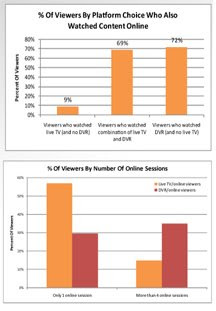
After having a great conversation regarding broadcast-television convergence with David Schepp, business news reporter (DailyFinance, Dow Jones, BBC News and Gannett), the subject has been on my mind again for the better part of the week.
Then today, my longtime friend Amy Vernon sent me an update on Boxee, which announced it will be launching a payment platform this summer. If you are unfamiliar with Boxee, it defines itself as a social media center that allows you to play videos, music, and pictures from your computer, local network, and the Internet on your television. The significance of such cannot be understated.
There will be no distinction between media and online media, right around the corner.
While some people consider Internet television the fourth method of distribution (alongside cable, satellite, IPTV) for broadcast and premium content, it really represents the singular distribution model of the future. For some smart phone purchasers, it's already difficult to distinguish the Internet from mobile.
The transition, which will continue to accelerate, will cause disruption because it places every distributor and service provider — AT&T, Boxee, Comcast, Charter, Cox, DirectTV, Sprint, Time Warner, Verizon, (to name a few) — in the same industry, with the only distinction being content creator or distributor/service provider (and even then those distinctions might overlap). It may also mean a contraction in related industries as it becomes more difficult for companies to ask consumers to pay for four services — phone, mobile, television, and Internet — that are being carried on what is essentially the same network.
What will the future look like? It seems crystal clear.
As a I told Schepp, the future will likely allow for our mobile devices to carry our preferences (and some content, as they do now) and then, once plugged in to another docking station, automatically pull up a customized desktop screen tailored to that device.
Specifically, I dock my iPhone (or whatever) to the television and all my preferred settings will be ported to the device. When I dock it to my desktop or laptop computer at work, ditto. When I dock it to my car stereo, I choose from my playlist or satellite radio. Calls and text messages can come through all devices, depending on my settings (which is important to anyone who has had a movie interrupted by a telephone call). It's simple, effective, and changes our thinking.
Online ... offline ... it all means communication and/or entertainment and/or mobile.
What does that mean for communication professionals?
While we're working on models that help companies better integrate social media into comprehensive communication, most of them are temporary five- to ten-year fixes. Just as the broadcast-mobile-Internet-cable mash up promises to erase our understanding of those industries, I anticipate there won't be any distinction between public relations, advertising, etc. It will all be communication, distinguished (perhaps) by previous world views.
Organizational communication will have to change, especially if consumers adopt a pay-for consumption only model, which could preclude advertising from the mix beyond product placement and peripheral marketing. (For example, maybe a customer becomes interested in the car their favorite character drives. One click and their programming could pause or be bookmarked for a future visit to the manufacturer's Web site. Another click inside the car, and GPS technology maps out the closest dealer or, perhaps, the one with the best deal).
Or, maybe, some companies will become content creators (with programs related to their products), competing with amateurs and production/broadcast companies or simply running alongside them as another option. Some of the better YouTube productions have already demonstrated the potential for advertainment, assuming we get more than an infomercial.
The applications are as endless as the imagination.
For me, the only thing more exciting than entertainment and communication changes ahead are the real life applications in areas such as education. When every classroom becomes a potential studio audience as it is streamed live across the Web (and any handouts are released to portable devices such as smart phones or tablets), it could potentially erase the barriers for higher education, with the most common barriers being proximity (physical location) and price points (mass audiences could reduce the current per credit rates).
What else? Anything is probable, but we can expect the road to be as bumpy as the transition from horses to horseless carriages or couriers to telephones. And speaking of phones ... have you thought about mobile lately?




































